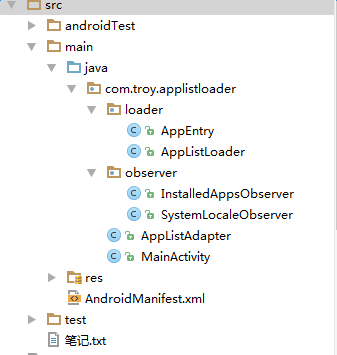Android非同步任務處理之AsyncTaskLoader的使用
最近專案中涉及到載入本地的地名.db檔案,資料量大,自然不能直接放在UI執行緒中操作,好在Google在Android3.0以後,提供了AsyncTaskLoader來做一些耗時的非同步任務。
一 官方對AsyncTaskLoader的定義及特點介紹如下:
Abstract Loader that provides an AsyncTask to do the workIntroduced in Android 3.0, loaders make it easy to asynchronously load data in an activity or fragment. Loaders have these characteristics:
1、They are available to every Activity and Fragment.
//支援Activity和Fragment
2、They provide asynchronous loading of data.
//非同步下載 (就是不影響UI執行緒)
3、They monitor the source of their data and deliver new results when the content changes.
//當資料來源改變時能及時通知客戶端
4、They automatically reconnect to the last loader’s cursor when being recreated after a configuration change. Thus, they don’t need to re-query their data.
//發生configuration change時自動重連線
二 實際專案介紹
下面引用官方的一個展示當前裝置所有已安裝應用程式的DEMO,來對AsyncTaskLoader的用法做一個詳細的介紹:
專案結構如圖:
第一步:我們需要寫一個對應於每一個應用程式的實體類,該實體類包含應用程式圖示和標籤兩個屬性。
AppEntry.java:
/**
* Created by Administrator on 2016/5/25.
*/
public class AppEntry {
private String mLabel;//應用文字標籤
private Drawable mIcon;//應用圖示
private final 第二步:需要寫一個自己的AppListLoader ,繼承自AsyncTaskLoader,並實現其相關抽象方法。
(1)onStartLoading:註冊一些監聽器到loader上,並且執行一次forceLoad(); 否則loader不會開始工作
(2)loadInBackground:不用說,在這裡就是載入資料並且返回,其實這個資料就返回到了LoaderManager的onLoadFinished方法第二個引數
(3)onStopLoading:停止載入資料,但不要停止監聽也不要釋放資料,就可以隨時重啟loader
(4)onReset:先確保已經停止載入資料了,然後釋放掉監聽器並設為null
(5)onCanceled: 在這裡可以釋放資源,如果是list就不需要做什麼了,但是象cursor或者打開了什麼檔案就應該關閉一下;
AppListLoader .java:
public class AppListLoader extends AsyncTaskLoader<List<AppEntry>> {
private static final String TAG = "ADP_AppListLoader";
private static final boolean DEBUG = true;
final PackageManager mPm;//包管理器
private List<AppEntry> mApps;//裝在應用程式實體的容器
// An observer to notify the Loader when new apps are installed/updated.
private InstalledAppsObserver mAppsObserver;//非系統應用程式安裝或者解除安裝的廣播接收器
// The observer to notify the Loader when the system Locale has been changed.
private SystemLocaleObserver mLocaleObserver;//系統應用程式安裝或者解除安裝的廣播接收器
public AppListLoader(Context context) {
super(context);
mPm = getContext().getPackageManager();
Log.i("TAG","AppListLoader(Context)");
}
@Override
protected void onStartLoading() {
Log.i("TAG","onStartLoading()");
if(mApps!=null){
deliverResult(mApps);
}
// Register the observers that will notify the Loader when changes are made.
if (mAppsObserver == null) {
mAppsObserver = new InstalledAppsObserver(this);//註冊一個非系統應用程式的接收器
}
if (mLocaleObserver == null) {
mLocaleObserver = new SystemLocaleObserver(this);//註冊一個系統應用程式的接收器
}
if (takeContentChanged()) {
forceLoad();
} else if (mApps == null) {
forceLoad();//強制載入資料
}
}
@Override
public void forceLoad() {
Log.i("TAG","forceLoad()");
super.forceLoad();
}
@Override
public List<AppEntry> loadInBackground() {
Log.i("TAG","loadInBackground()");
List<ApplicationInfo> apps=mPm.getInstalledApplications(0);
// public static final int FILTER_ALL_APP = 0; // 所有應用程式
// public static final int FILTER_SYSTEM_APP = 1; // 系統程式
// public static final int FILTER_THIRD_APP = 2; // 第三方應用程式
// public static final int FILTER_SDCARD_APP = 3; // 安裝在SDCard的應用程式
if(apps==null){
apps=new ArrayList<>();
}
List<AppEntry> entries=new ArrayList<>(apps.size());
//開始載入資料
for(int i=0;i<apps.size();i++){
AppEntry appEntry=new AppEntry(this,apps.get(i));
appEntry.loadLabel(getContext());
entries.add(appEntry);
}
//Sort the list
Collections.sort(entries,ALPHA_COMPARATOR);//對應用程式進行排序
return entries;
}
@Override
public void deliverResult(List<AppEntry> datas) {//分發loadInBackground()方法返回的結果
Log.i("TAG","deliverResult()");
if(isReset()){
if(datas!=null){
releaseResources(datas);//可以釋放相關資源
return;
}
}
List<AppEntry> oldApps=mApps;
mApps=datas;
if(isStarted()){
super.deliverResult(datas);
}
if(oldApps!=null&&oldApps!=datas){
releaseResources(oldApps);
}
}
@Override
protected void onStopLoading() {//停止載入資料
Log.i("TAG","onStopLoading()");
cancelLoad();
}
@Override
protected void onReset() {
Log.i("TAG","onReset()");
onStopLoading();
// At this point we can release the resources associated with 'apps'.
if (mApps != null) {
releaseResources(mApps);
mApps = null;
}
// The Loader is being reset, so we should stop monitoring for changes.
if (mAppsObserver != null) {
getContext().unregisterReceiver(mAppsObserver);//登出廣播接收器
mAppsObserver = null;
}
if (mLocaleObserver != null) {
getContext().unregisterReceiver(mLocaleObserver);//登出廣播接收器
mLocaleObserver = null;
}
}
@Override
public void onCanceled(List<AppEntry> apps) { // Attempt to cancel the current asynchronous load.
super.onCanceled(apps);
Log.i("TAG","onCanceled()");
releaseResources(apps);
}
/**
* Helper method to take care of releasing resources associated with an
* actively loaded data set.
*/
private void releaseResources(List<AppEntry> apps) {
// For a simple List, there is nothing to do. For something like a Cursor,
// we would close it in this method. All resources associated with the
// Loader should be released here.
}
/**
* Performs alphabetical comparison of {@link AppEntry} objects. This is
* used to sort queried data in {@link }.
*/
private static final Comparator<AppEntry> ALPHA_COMPARATOR = new Comparator<AppEntry>() {
Collator sCollator = Collator.getInstance();
@Override
public int compare(AppEntry object1, AppEntry object2) {
return sCollator.compare(object1.getLabel(), object2.getLabel());
}
};
}第三步:在MainActivity中呼叫AsyncTaskLoader,並繼承LoaderManager.LoaderCallbacks的介面,重寫介面方法:
(1)onCreateLoader: 這個是建立一個AsyncTaskLoader並返回,我們在裡面new一個自己寫的AppListLoader並返回就OK了;
(2)onLoadFinished: 這個是載入完成後可以更新UI,在這裡就是setAdapter了 而這個載入過程其實就是在CursorLoader裡面完成的,
只不過系統幫我們完成了,而如果自定義loader的話就要自己完成,這就是區別;
(3)onLoaderReset: loader的重置,在這裡一般讓UI不顯示資料就行;
MainActivity .java:
public class MainActivity extends FragmentActivity {
@Override
protected void onCreate(Bundle savedInstanceState) {
super.onCreate(savedInstanceState);
//將AppListFragment新增到當前的activity裡
FragmentManager fm=getSupportFragmentManager();
if(fm.findFragmentById(android.R.id.content)==null){
AppListFragment list=new AppListFragment();
fm.beginTransaction().add(android.R.id.content,list).commit();
}
}
//實現LoaderManager.LoaderCallbacks的介面
public static class AppListFragment extends ListFragment implements LoaderManager.LoaderCallbacks<List<AppEntry>>{
private static final String TAG = "ADP_AppListFragment";
private static final boolean DEBUG = true;
private AppListAdapter mAdapter;
private static final int LOADER_ID = 1;
@Override
public void onActivityCreated(@Nullable Bundle savedInstanceState) {
super.onActivityCreated(savedInstanceState);
setHasOptionsMenu(true);
mAdapter=new AppListAdapter(getActivity());
setEmptyText("No Applications");
setListAdapter(mAdapter);
setListShown(false);
if (getLoaderManager().getLoader(LOADER_ID) == null) {
Log.i("TAG", "Initializing the new Loader...");
} else {
Log.i("TAG", "Reconnecting with existing Loader (id '1')...");
}
getLoaderManager().initLoader(LOADER_ID, null, this);
}
@Override
public Loader<List<AppEntry>> onCreateLoader(int id, Bundle args) {
Log.i("TAG", "onCreateLoader()");
return new AppListLoader(getActivity());
}
@Override
public void onLoadFinished(Loader<List<AppEntry>> loader, List<AppEntry> data) {
Log.i("TAG", "onLoadFinished()");
mAdapter.setData(data);
if(isResumed()){
setListShown(true);
}else {
setListShownNoAnimation(true);
}
}
@Override
public void onLoaderReset(Loader<List<AppEntry>> loader) {
Log.i("TAG", "onLoaderReset()");
mAdapter.setData(null);
}
}然後執行程式如下:
開啟應用,AppListLoader中核心方法執行的先後順序:
05-25 12:57:46.050 11184-11184/com.troy.applistloader I/TAG: +++ Calling initLoader()! +++
05-25 12:57:46.050 11184-11184/com.troy.applistloader I/TAG: +++ Initializing the new Loader... +++
05-25 12:57:46.050 11184-11184/com.troy.applistloader I/TAG: onCreateLoader()
05-25 12:57:46.050 11184-11184/com.troy.applistloader I/TAG: onStartLoading()
05-25 12:57:46.060 11184-11184/com.troy.applistloader I/TAG: forceLoad()
05-25 12:57:46.060 11184-13196/com.troy.applistloader I/TAG: loadInBackground()
05-25 12:57:47.530 11184-11184/com.troy.applistloader I/TAG: deliverResult()
05-25 12:57:47.530 11184-11184/com.troy.applistloader I/TAG: onLoadFinished()按返回鍵,會執行的方法及執行順序:
05-25 13:00:08.790 11184-11184/com.troy.applistloader I/TAG: onStopLoading()
05-25 13:00:08.790 11184-11184/com.troy.applistloader I/TAG: onLoaderReset()
05-25 13:00:08.790 11184-11184/com.troy.applistloader I/TAG: onReset()
05-25 13:00:08.790 11184-11184/com.troy.applistloader I/TAG: onStopLoading()三 總結
本專案的學習之後,我們應該掌握以下幾點:
(1)理解AsyncTaskLoader的每一個核心方法的作用及呼叫時機,以及如何自定義一個AsyncTaskLoader。
(2)如何在Fragement中啟動AsyncTaskLoader,繼承LoaderManager.LoaderCallbacks,實現介面的三個方法。
(3)應該瞭解AsyncTaskLoader的底層實際上是執行的AsyncTask,這個可以看看原始碼。
(4)如何應用ApplicationInfo,獲取相關的程式資訊。


